Measures to combat powdery mildew on currants, if berries have already appeared in spring
Powdery mildew (linen, ash) is an insidious disease that can deprive the gardener of the currant crop without treatment. The disease is caused by powdery mildews. The situation is aggravated by the lightning-fast spread of spores from one bush to another. We will tell you in detail what this disease is and how to treat it.
The content of the article
How to recognize powdery mildew on currants
Powdery mildew is a fungal disease that affects leaves and fruits.... Black currant is usually susceptible to infection. Gold, red and white rarely get sick. Spores of the fungus can withstand low and high air temperatures, hibernate in the ground and plant debris.
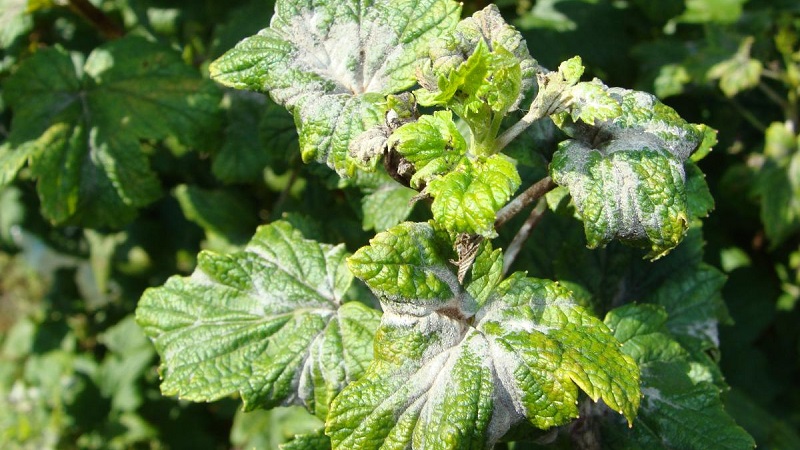
Causes of infection of bushes:
- proximity to infected areas;
- humid and warm air;
- weeds under bushes;
- excess nitrogen in the soil;
- strong pruning;
- dense planting.
Black currant is sick with powdery mildew 2 times a year —After flowering and during the ripening period of the berries.
Symptoms:
- white bloom on the tops of the shoots;
- brown spots on leaves and branches;
- plant growth retardation;
- deformation and drying of shoots;
- curled and pale leaves;
- whitish bloom on berries and cessation of growth;
- deterioration of fruit taste.
During fruiting, powdery mildew affects berries, shoots, fruit branches... The plant stops growing, dries up, loses its protective forces, its resistance to frost decreases.
Interesting on the site:
Currant diseases, methods of control and prevention
Measures to combat white bloom
Control measures for powdery mildew on currants include the use of chemicals and folk remedies. The number of treatments depends on the season and the growing season of the plant.

How to process in spring
The fight against powdery mildew begins in early spring... In the gardener's arsenal there are always chemical and folk remedies... Frequent spraying with fungicides causes the resistance of the fungus. In addition, chemicals are contraindicated once ovaries appear.
Spring treatment includes spraying bushes and tree trunk circle... Fungicides have a different duration of action, therefore, to prolong the therapeutic effect, the procedure is performed several times.
Before the snow melts at the top of the shoots quickly dipped in a bucket of boiling water. This method is often used in practice, as it reduces the risk of infection by 60-70%.
The topsoil is replaced with new humus... Together with the old layer, it is possible to remove the spores of the fungus wintering in the soil.
Before the buds swell, the plants are treated with a solution of copper sulfate and carry out water-charging irrigation. Before foliage appears, it is difficult to know if the bushes are infected or not. Treatment is started immediately after the detection of whitish spots on the greenery. Processing is carried out 3-4 times, following the manufacturer's recommendations.
Powdery mildew of currants is treated with biofungicides and chemicals.
Biofungicides - these are biological agents that suppress the vital activity of the causative agent of the disease. They contain bacteria that destroy the shell of the fungus. The products are harmless to humans, birds and bees. Processing can be carried out at any time. Given the short duration and water solubility of biological products, spraying is repeated every 5-7 days until a satisfactory result is obtained.

Chemicals - these are pesticides with a toxic effect on the environment, therefore, treatments are performed in protective clothing, gloves, glasses and a respirator. Fungicides contain heavy metals that accumulate in soil and plant tissues. Therefore, the treatment of currants is carried out strictly according to the instructions, observing the frequency of treatments.
Plant protection lasts longer. To destroy the fungus, 3-4 treatments per season are enough. Systemic fungicides are more effective. They protect bushes from fungus and prevent infection. Similar tools are used to treat large areas. If a small area is infected with powdery mildew, use protective fungicides. The solution envelops the leaves and shoots with a layer of active substances, does not penetrate the ovaries and leaf plates and prevents infection. Processing is carried out in the evening, in dry, calm weather.
Reference. In the spring, agents with dithiocarbamic acid are used to stimulate plant growth. In summer, preference is given to copper-containing preparations.
Metronidazole
The active ingredient is trichopolum. The antibacterial drug comes in tablets and is sold at any pharmacy... To prepare the solution, take 3 tablets for 0.5 liters of water and process the bushes. It is recommended to carry out the first spraying before flowering, the second in late May - early June. If the symptoms have not disappeared after a week, the treatment is carried out every day until complete recovery.
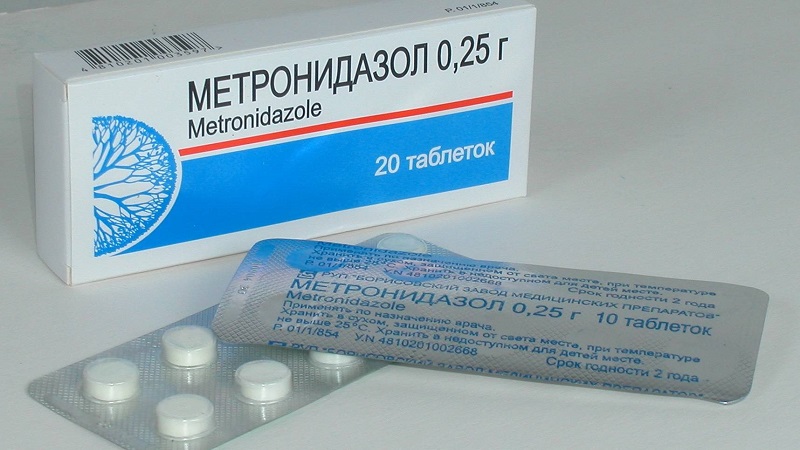
Boric acid
The tool is used for foliar dressing when the plant lacks boron... The processing stimulates the growth of berries, improves their taste and meatiness. To prepare the solution, take 2 g of each substance per 10 liters of water, add 40 drops of iodine, irrigate the bushes immediately after the appearance of foliage and repeat during the flowering period and the formation of the ovary.
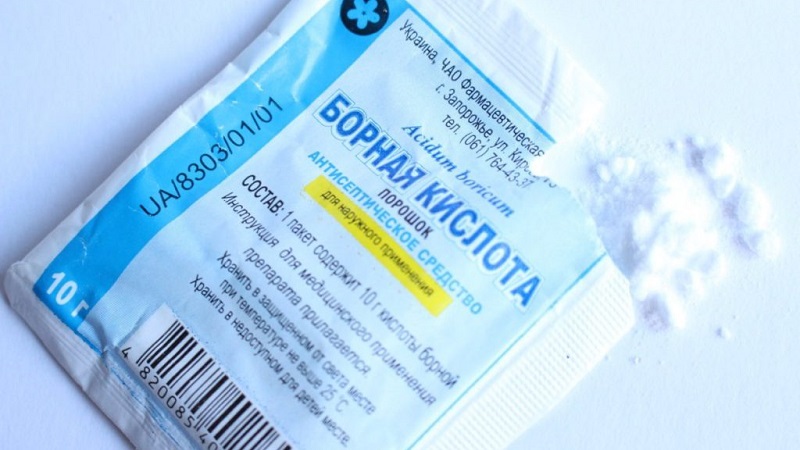
Bordeaux liquid
The solution is prepared from slaked lime, copper sulfate and water... It is a versatile remedy for fighting fungal infections. The advantage of Bordeaux liquid is long-term action. One treatment per month is enough to protect against fungus. The product stays on greenery and is not washed off with water. For prophylaxis, currants are treated with a 1% solution in early spring before the onset of bud swelling. If the bushes are partially infected, the treatment is performed 3 times: before the appearance of leaves, at the beginning of the growing season and after flowering. In case of mass infection, currants are sprayed up to 6 times a season. The last treatment is carried out 2-3 weeks before harvest.
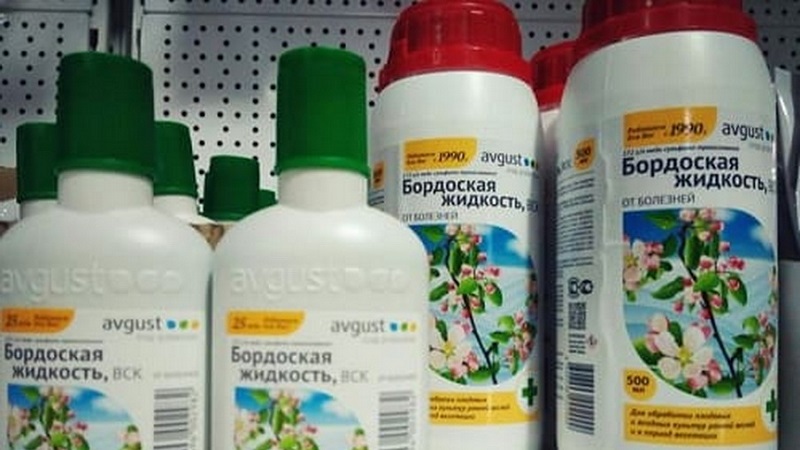
Copper sulfate
For spraying currants, use a 1% solution... Processing is carried out before bud break. In case of mass infection, 4-5 treatments are carried out every 10-14 days. For better adhesion to the foliage, add 50 g of laundry soap to 10 liters of solution.
"HOM"
It is a potent copper-containing drug... Currant bushes are treated with a 0.4% solution - 40 g per 10 liters of water. The product is mixed with "Fufanon" and "Decis" in 1 bottle for complex treatment against fungal diseases. Spraying is performed once - before flowering.
"Speed"
Broad-acting chemical fungicide with difenoconazole... The active ingredient inhibits the reproduction of mycelium, reduces the focus of infection and completely eliminates powdery mildew from the plant. The action of the drug begins 2 hours after irrigation. Rain and wind do not reduce the effectiveness of the drug. For 10 liters of water, take 2 ml of the product. Preventive treatment is carried out twice with an interval of 10-12 days, treatment - every 7 days.

Fitosporin
Bacteriological biofungicide inhibits mycelium growth, is used to treat and prevent powdery mildew. The contents of the bag are poured into a small amount of water, stirred and left for 5-6 hours. For 10 liters of water take 1 tbsp. l. suspension and spray the currants. Processing is carried out once - in early spring. If the bushes are sick, re-spraying is pointless.
Fundazol
Fungicide with benomyl in the composition... The active substance disrupts cell division and prevents the growth of the fungus.The protective effect lasts 13-14 days. The tool is used to treat leaves, shoots and soil. For 1 liter of water, take 1 ml of the drug. The first treatment is performed at the first symptoms of infection, the second - after 2 weeks.
"Topaz"
Fungicide with penconazole in the composition... The drug is compatible with insecticides and other fungicides, is economically consumed, and retains its effect for 2-3 weeks. The composition stops mycelium growth 3 hours after treatment. For 10 liters of water, take 2 ml of the product and spray the currants at the first symptoms of infection. The interval between procedures is 7-8 days. Consumption per bush - 1.5 liters. The multiplicity of treatments is 3 times.
"Previkur"
Systemic drug with prolamocarbofosethyl in the composition... The active substance penetrates the leaves, inhibits the growth of fungus, stimulates the development of leaves and berries. For 1 liter of water, take 5 ml of the product. The solution is carefully treated with foliage and soil around the bushes. Re-spraying - after 10-14 days.

During fruiting and ripening
During the period of fruiting and ripening, black currants are not recommended to be treated with fungicides.... Control measures, if berries have already appeared, include the use of natural remedies, colloidal sulfur and copper sulfate. Plants are processed in dry weather.
Folk remedies recipes:
- 1 liter of whey per 10 liters of water. The frequency of bushes processing is 3 times every 3 days. A milky film envelops leaves, shoots and berries, blocking oxygen from the mycelium.
- 2 tbsp. l. soda, 2 tbsp. l. liquid soap for 10 liters of water. The frequency of treatment is 2 times with a break per week.
- 50 g of soda, 10 ml of liquid soap per 10 liters of water. The bushes are treated with a solution 2 times - before and after flowering.
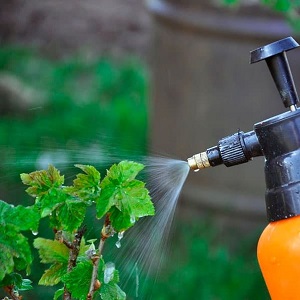 300 g of wood ash per 5 liters of water is brought to a boil, cooled, filtered and sprayed with currants. The frequency of treatment is every 10-12 days until the signs of the disease disappear completely.
300 g of wood ash per 5 liters of water is brought to a boil, cooled, filtered and sprayed with currants. The frequency of treatment is every 10-12 days until the signs of the disease disappear completely.- 50 g of potassium chloride, 30 g of urea, 20 g of superphosphate, 5 g of potassium permanganate per 10 liters of warm water. The solution is used for a single spraying of bushes. It serves both as a treatment for currants and as a top dressing.
- 10 ml of rapeseed oil per 10 liters of water. The solution is used for a single spraying of bushes.
- 1 tbsp. l. soda, 1 aspirin tablet, 1 tsp. liquid soap, 1 tbsp. l. vegetable oil in 5 liters of water. The bushes are treated once, the berries are washed after harvesting under running water.
- 30 g of soda ash, 5 g of grated laundry soap per 5 liters of water. A single treatment is enough.
- 100 g of horsetail greens per liter of water. Insist for 24 hours, pour into a container with a spray and process the bushes.
- 5 g of copper sulphate, 30 g of grated laundry soap per 10 liters of water. The processing frequency is once.
- Treatment of bushes with cow dung diluted with water in a ratio of 1:10.
- 30 g of colloidal sulfur per 10 liters of water. The processing frequency is once.
After harvesting, the site is completely cleared of weeds, plant residues and burned... The soil is treated with a solution of copper sulfate.
Conclusion
The success of the treatment of white bloom on currant leaves depends on the method chosen. In mild cases, prophylactic spraying with Bordeaux liquid, copper sulfate or "Fitosporin" is sufficient. In case of mass infection, they use "heavy artillery" - chemical fungicides. Such funds are allowed to be used before flowering.
During the ripening period, folk remedies are used based on baking soda and soda ash, milk whey, rapeseed oil, wood ash, and field ivy. In the fall, the site is completely cleared of debris, and in the spring, the topsoil is changed to a new one.